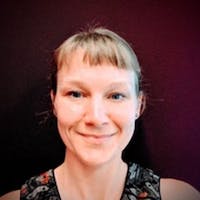One Foot in Academia, One in Industry: Professionals Who Teach
Being able to rattle off models and technologies might make you look experienced in a short conversation. But I know from experience that the real job also involves answering ambiguous questions and critical thinking that don’t come directly from academic research.
Katrina Glaeser, Data Scientist at Scribd and Instructor for UC Davis Extension
It is an uncertain time for education. On the one hand, the higher education marketplace in the U.S. is deteriorating; the country has a huge shortage of teachers, and students are loaded with college debt. Democratic presidential candidates are calling for free public colleges, and the number of high school graduates is in decline.
On the other hand, the e-learning sector is booming. Funding to VC-backed edtech startups grew by more than 500 percent between 2010 and 2015. The U.S. online education industry has surpassed $107 billion and is expected to triple by 2025.
MOOCs—massive open online courses—have lowered the barrier to entry for students wishing to learn a new trade. Advances in technology have made distance learning more accessible and more engaging and traditional academic institutions like colleges and universities have fully embraced online education. What’s more, companies are now turning to online education to help fill the talent gap and train a new workforce.
E-learning today spans all sorts of platforms, degrees, certifications, and approaches to learning. Coursera partners with universities as well as companies to provide synchronous and asynchronous programs, from certificates to degrees. 2U works exclusively with top-tier universities such as Yale, Harvard, and Oxford, to provide the same level of education online as in the classroom. Many other colleges and universities offer their own programs powered by a suite of edtech tools.
Just as the type of online education varies, the teachers of these classes are diverse. While some come from academia, the field of online learning has seen an emergence of experts working between industry and academia.
Working Experts Who Teach: deeplearning.ai’s Kian Katanforoosh

Kian Katanforoosh works at the intersection of machine learning and education. He first dabbled in edtech when he started Daskit, a software-as-a-service fostering in-class interaction between students and teachers primarily in higher education while studying engineering at the École Centrale Paris (now École CentraleSupélec) in France. Then while studying at Stanford, he helped create a “Blockchain, Bitcoin and Cryptocurrencies” class at with Dan Boneh.
“It was my first experience with recorded lectures, discussion sessions, and office hours provided for both online and on-campus students,” he recalls. After that, he co-created the Deep Learning Specialization on Coursera with company founder Andrew Ng and Younes Bensouda Mourri.
In the deep learning course, students from all around the world watch lectures, answer quizzes and learn how to implement code in cloud-based auto-graded programming assignments. Most recently, Katanforoosh created a blended online and on-campus class at Stanford University on deep learning with Ng.
“We offer a flipped classroom,” explains Katanforoosh. “The theoretical content is delivered mostly online, while in-class sessions focus on practical case studies, career advice, and interactive problem-solving. Students form groups for their ten-week class project and meet their teaching assistant (TA) project mentor every other week to finally deliver a report and codebase.”
The course has been wildly successful so far. It grew from 30 students in its first quarter to more than 500.
Today, Katanforoosh balances education and industry work as a lecturer of computer science at Stanford University and a founding member at deeplearning.ai. Although it varies depending on the quarter, he typically dedicates one weekday and weekends to his academic work. During the other four weekdays, he works on other industry or startup projects. While it can be challenging to balance two roles, the logistics are easy for him since his work office is in Palo Alto, the neighboring town to Stanford.
Working Experts Who Teach: Google’s Laurence Moroney

Laurence Moroney is another expert balancing work and academia; however, his academic and industry work are the same. He is an artificial intelligence advocate at Google and an expert in TensorFlow, an open-source machine learning library. He is also currently working with deeplearning.ai and Coursera to produce video training on the subject.
“I had written a lot of programming books, and online education seemed to be a natural extension of this,” explains Moroney. “My first experiences of doing it were a lot of fun and were very rewarding, so I ended up going much deeper.”
At Google, he is responsible for growing TensorFlow with software developers. He runs the TensorFlow YouTube channel and he is a regular keynote and technical speaker at conferences all over the world. He also is an instructor in the Coursera deeplearning.ai specialization course “TensorFlow: In Practice.” More than 7,500 students have already enrolled in the two-month program.
“It’s easy to learn stuff in computing, it’s hard to learn the relevant stuff,” explains Moroney, and his professional experience can prepare students for where the industry is headed. “As Wayne Gretsky said about hockey, ‘you don’t skate to where the puck is, you skate to where it’s going.’ With my industry experience, I know where things are going, so I like to help students be prepared for that.”
Working Experts Who Teach: Scribd’s Katrina Glaeser

Katrina Glaeser agrees that there is so much information available online that it can be overwhelming for even motivated learners to find the relevant information they need.
“There are not really any consequences for a student who decides not to continue an online course, except perhaps the financial commitment they have made. So the course needs to earn their trust quickly and keep it by staying focused on practical goals,” says Glaeser, a data scientist at Scribd and a course instructor at the University of California, Davis School of Continuing and Professional Education. “If the course delivers on this promise it can be a much more efficient way to cover material than self-study—and much cheaper than in-person options.”
Glaeser first got into online education while studying for her master’s degree. As a teaching assistant, she did some video work for a linear algebra course at UC Davis, which was then made available online. A few years later, she helped create the “Data Wrangling, Analysis, and AB Testing with SQL” course for UC Davis.
Inspiration for the course came when she was hiring data science candidates for roles at her company. Many candidates focused on machine learning and other data science-adjacent technologies through a traditional academic angle, but she was looking for candidates with a more practical understanding of these concepts.
“Being able to rattle off models and technologies might make you look experienced in a short conversation. But I know from experience that the real job also involves answering ambiguous questions and critical thinking that don’t come directly from academic research,” she says. “I wanted to give students a framework for thinking about the kinds of problems I face in my real-life work, and the opportunity to practice in a low-stakes environment. These are the kinds of skills that fill the gap from academia and that I’d want a coworker to have.”
Students can benefit a lot from industry experts and in ways they can’t from academics. Where professors tend to be more theoretical and philosophical, working professionals are better equipped to prepare students for real-life scenarios of a subject.
The Challenges of Teaching Online Courses
When building the deep learning specialization, Katanforoosh and his team spent more than three months gathering information from industry experts to build the most effective deep learning syllabus.
“As a teacher, understanding what’s happening on the job is key information to account for when building course material. It’s a huge advantage,” says Katanforoosh. “You don’t want to teach an algorithm that will be outdated in a year or two. If you investigated well, your syllabus should still be relevant in five to ten years! More than ten years would be a major feat in higher education, especially in fast-moving industries such as computer science and artificial intelligence.”
“One of the hardest parts about developing an online course is how long it takes to make,” Glaeser admits. “My four-week course took almost a year to develop. I outlined the course and recorded a sample video to submit to Coursera for approval, before I built a complicated realistic dataset from scratch, with all kinds of hidden surprises for learners to find.”
After she got the go-ahead from Coursera, she had to take time outside of her full-time job to create exercises and solutions, draft and film lectures, and create quizzes to test comprehension at each stage. A few minutes of video can take hours to create, and once the course was in beta, she spent months tweaking errors. She also made changes to the way programming assignments were distributed based on user feedback, which meant a whole other round of revisions.
“The first session of my course opened at the beginning of the month, and it is so exciting and rewarding to see students making progress,” explains Glaeser. “One of the things that motivated me was getting a years later thank-you email from a student I’d mentored through a local university. It was a good reminder that I can be helpful to students who don’t happen to live near me.”
Not only are there months of development and production, but also Katanforoosh notes that online teachers need to be particularly attuned to how their classes scale. In a traditional setting, if 10 percent of your class of 38 students is confused, that’s four people. You can sit down and talk through their confusion. In a large online course of 500, 10 percent of the class is 50 students.
“Add to this the network effects and in less than an hour, half of the class is confused. It will take you much longer to clear the confusion,” explains Katanforoosh. “All in all, when teaching a large class, you need to be either extremely rigorous or tackle problems at the speed of light. Hopefully, you’re both.”
The preparation of an online course can be the hardest—and most arduous—part, but the maintenance of the class is just as critical. Katanforoosh sources feedback from alumni who go on to work in the industry so that he can learn about what worked and what didn’t work in his classes.
“To provide meaningful career advice to new students, I need feedback loops from alumni who are now working in the industry,” he says. “I need to know who’s happy, who’s unhappy, who’s learning well, who’s not. […] This constant feedback helps me mentor my students to make good decisions for their career.”
Professionals are uniquely positioned to offer relevant and timely education on industry concepts because they are the ones living it. They can breathe agility into the traditionally rigid world of education and help mitigate the shortage of teachers.
They can also share their cutting-edge knowledge. For example, there are few experts in sub-domains of machine learning and AI, such as object detection. Online learning allows experts to scale their teaching and reach more people so that they can build a more robust industry. Perhaps the future of education is in professionals across all industries sharing their knowledge and teaching students around the world while also maintaining a foothold in their chosen industry.
The best online education is open to everyone. It doesn’t require thousands of dollars or entrance exams. It just asks for motivated students and teachers regardless of their background or geographic location.
Moroney recalls a program he ran with retired National Hockey League players. They barely had high school diplomas and had lived their lives in the rink. He taught them how to become Android software developers and many completed the course with software development skills that they only thought could be achieved with a four-year degree.
“It’s a massively impactful field,” says Moroney, “and I think all industry experts should try to share their knowledge en masse.”
